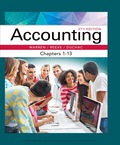
Statement of
Indirect method: Under this method, the following amounts are to be adjusted from the Net Income to calculate the net cash provided from operating activities.
Cash flows from operating activities: These are the cash produced by the normal business operations.
The below table shows the way of calculation of cash flows from operating activities:
| Cash flows from operating activities (Indirect method) |
| Add: Decrease in current assets |
| Increase in current liability |
| |
| Loss on sale of plant assets |
| Deduct: Increase in current assets |
| Decrease in current liabilities |
| Gain on sale of plant assets |
| Net cash provided from or used by operating activities |
Table (1)
Cash flows from investing activities: Cash provided by or used in investing activities is a section of statement of cash flows. It includes the purchase or sale of equipment or land, or marketable securities, which is used for business operations.
The below table shows the way of calculation of cash flows from investing activities:
| Cash flows from investing activities |
| Add: Proceeds from sale of fixed assets |
| Sale of marketable securities / investments |
| Interest received |
| Dividend received |
| Deduct: Purchase of fixed assets/long-lived assets |
| Purchase of marketable securities |
| Net cash provided from or used by investing activities |
Table (2)
Cash flows from financing activities: Cash provided by or used in financing activities is a section of statement of cash flows. It includes raising cash from long-term debt or payment of long-term debt, which is used for business operations.
The below table shows the way of calculation of cash flows from financing activities:
| Cash flows from financing activities |
| Add: Issuance of common stock |
| Proceeds from borrowings |
| Proceeds from issuance of debt |
| Issuance of bonds payable |
| Deduct: Payment of dividend |
| Repayment of debt |
| Interest paid |
| Redemption of debt |
| Repurchase of stock |
| Net cash provided from or used by financing activities |
Table (3)
To Prepare: A statement of cash flows using the indirect method for presenting cash flows from operating activities.
Trending nowThis is a popular solution!

Chapter 16 Solutions
EBK ACCOUNTING, CHAPTERS 1-13
- Please help me solve this financial accounting problem with the correct financial process.arrow_forwardPlease provide the accurate answer to this general accounting problem using appropriate methods.arrow_forwardI need help finding the accurate solution to this general accounting problem with valid methods.arrow_forward
- in the “Problems – Series A” section 8-19A of Ch. 8, “Performance Evaluation” of Fundamentals of Managerial Accounting Concepts. Scenario: The Redmond Management Association held its annual public relations luncheon in April Year 2. Based on the previous year’s results, the organization allocated $25,290 of its operating budget to cover the cost of the luncheon. To ensure that costs would be appropriately controlled, you, the treasurer, prepared the following budget for the Year 2 luncheon. Usin Excel—showing all work and formulas—to complete the following: I need help Preparing a flexible budget. Computing the sales volume variance and the variable cost volume variances based on a comparison between the master budget and the flexible budget. And Computing flexible budget variances by comparing the flexible budget with the actual results.arrow_forwardI am searching for the accurate solution to this financial accounting problem with the right approach.arrow_forwardCher Enterprises reported net income of $2,100,000. The average total liabilities were $6,800,000 and the average total stockholders' equity was $7,400,000. Interest expense was $250,000 and the tax rate was 30%. What is the return on assets ratio?arrow_forward
 Intermediate Accounting: Reporting And AnalysisAccountingISBN:9781337788281Author:James M. Wahlen, Jefferson P. Jones, Donald PagachPublisher:Cengage Learning
Intermediate Accounting: Reporting And AnalysisAccountingISBN:9781337788281Author:James M. Wahlen, Jefferson P. Jones, Donald PagachPublisher:Cengage Learning Financial Accounting: The Impact on Decision Make...AccountingISBN:9781305654174Author:Gary A. Porter, Curtis L. NortonPublisher:Cengage Learning
Financial Accounting: The Impact on Decision Make...AccountingISBN:9781305654174Author:Gary A. Porter, Curtis L. NortonPublisher:Cengage Learning Managerial AccountingAccountingISBN:9781337912020Author:Carl Warren, Ph.d. Cma William B. TaylerPublisher:South-Western College Pub
Managerial AccountingAccountingISBN:9781337912020Author:Carl Warren, Ph.d. Cma William B. TaylerPublisher:South-Western College Pub Financial And Managerial AccountingAccountingISBN:9781337902663Author:WARREN, Carl S.Publisher:Cengage Learning,
Financial And Managerial AccountingAccountingISBN:9781337902663Author:WARREN, Carl S.Publisher:Cengage Learning, College Accounting (Book Only): A Career ApproachAccountingISBN:9781337280570Author:Scott, Cathy J.Publisher:South-Western College Pub
College Accounting (Book Only): A Career ApproachAccountingISBN:9781337280570Author:Scott, Cathy J.Publisher:South-Western College Pub





